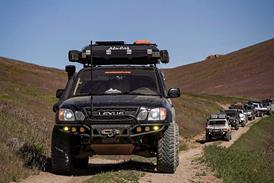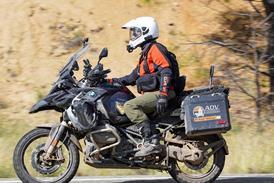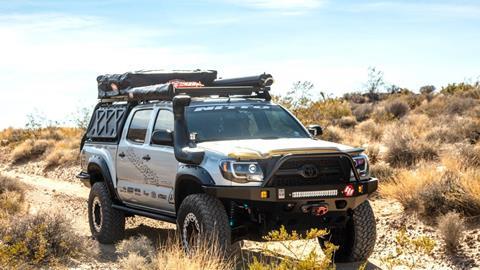Overlanding and camping are a pair of terms that are often lumped together when discussing adventure-type hobbies and activities. While there is certainly overlap between these two worlds, there are also important differences that separate overlanders from campers.
Written by Benjamin Hunting of DrivingLine, the following story is provided in partnership with Nitto Tire USA. @NittoTire
Being familiar with one doesn’t necessarily prepare you for the other, and being prepared is the most important thing when heading into the great outdoors. Here’s how overlanding and camping compare to each other.
Exploration is the Focus
One of the key differences separating overlanding from camping is its emphasis on active exploration. Rather than simply making one’s way to the campsite, setting up, and then enjoying the weekend, overlanding centers itself around the journey and makes transportation to and from the wilderness a key component of the overall experience.

How does that focus express itself from a practical perspective? It’s helpful in some ways to compare overlanding to hiking rather than camping. Both overlanding and hiking are activities where the fun is focused on moving through new landscapes, obstacles, and weather conditions, pushing into fresh territory and savoring the experiences that come with it. Camping can be a part of hiking, but it’s not the driving force for hitting the trail.
To put it more succinctly, camping is an activity where the destination is what’s most important, whether that’s a quiet spot by a lake or a commercial campground packed with a pool, a softball diamond, and a hundred other families. Overlanding redirects the energy into the expedition itself.
Choosing the Right Vehicle
In order to explore, you need a vehicle that can do more than just get you to a campsite at your local KOA. While theoretically, camping can be accomplished in almost any completely stock automobile ranging from a small hatchback on up to a minivan, overlanding is an activity that relies on more rugged fare such as a truck or SUV that has been prepared specifically to tackle the challenge.

That being said, there’s a misconception that overlanding requires an ultra-rugged 4x4 to do ‘properly.’ The truth is, as long as the vehicle in question can handle the terrain you plan to traverse and has the capacity to haul the gear you need for a successful trip, there’s no need to focus on all-out all-terrain competence.

In fact, a big part of why overlanding has grown in popularity in recent years has to do with the explosion in popularity of crossover utility vehicles. Featuring respectable cargo storage, decent ground clearance, and traction-adding all-wheel drive, crossovers are more than capable of dealing with the grassy lanes, fire roads, and gravel paths that make up a big chunk of where overlanders find themselves exploring.

Since overlanding is about the journey, it’s key to pack the kind of equipment that can deal with the unexpected out on the trail. Depending on where you are heading, this can mean traction aids, a full-size spare tire and off-road jack, and an air compressor, but it also means making room for extra food, water, and supplies should you get stuck somewhere longer than you had planned.

An overlanding rig also needs to haul a full sleep setup to get you through the weekend (usually inside the vehicle, but sometimes a small trailer or a roof or cargo bed tent), enough batteries and power to keep your devices going, and a cooking setup so you can eat well.
It goes without saying that a first aid kit and adequate communications gear to use in case of an emergency are also baked into any overlanding rig

Planning the Journey
The final major difference between overlanding and camping has to do with planning. When camping, it’s enough to know the destination and the most expedient way to get to it. Overlanding, on the other hand, means choosing a path that is equal parts challenging and fun, and taking advantage of an area’s geography to maximize the beauty and interest of the journey itself.

Just as overlanding isn’t about getting from A to B as quickly as possibly, planning out a trip also requires taking into account any restrictions imposed by the vehicles that are being driven (ground clearance, availability of low-range four-wheel drive, fuel range), distance from resources (fuel stops, emergency medical care), and the amount of gear that can be hauled in (food and water supplies, etc).
Then there’s the fact that overlanding expeditions tend to involve not just one campsite but several, or rely on finding a hospitable place to stop and spend the night while en-route. Similar to hiking, the latter requires a familiarity with the trail in order to know when to press on and when it’s time to retire for the night. Overlanding trips can last for days, weeks, or even months at a time, with logistics that go well beyond selecting a campsite and paying a park access fee.

No Wrong Answer
Overlanding and camping both exist in the same continuum of people enjoying the great outdoors. Which one is right for you is entirely a matter of personal preference, as there’s no ‘correct’ answer when choosing whether you prefer the stability of traditional camping or the onward-bound energy of an overland journey. Each adventure has different requirements when it comes to gear, planning, and vehicle choice, but the end result is the same: enjoying the millions of square miles of beautiful public land available to Americans in parks and preserves across the entire country.
The following story is provided in partnership with Nitto Tire USA.
Access More Great Stories!
For more informative articles like this, consider subscribing to OVR Magazine in print or digital versions here. You can also find the print edition of OVR at your local newsstand by using our Magazine Finder.





















No comments yet